Public Speaking
Public speaking means connecting with a live audience, establishing a relationship with them, and hopefully changing their perspective on an issue or topic through the power of your voice.
What You’ll Learn:
- Why public speaking is important
- Why master the art of verbal communication
- What role non-verbal communication plays
- How to speak with your own style
If you’re afraid of public speaking, you’re not alone. According to John Montopoli (2017), a therapist at the National Social Anxiety Center, “The fear of public speaking is the most common phobia ahead of death, spiders, or heights. The National Institute of Mental Health reports that public speaking anxiety, or glossophobia, affects about 73% of the population.”
So how do you overcome a fear of public speaking? You can ask yourself: What is it that I’m afraid of? Then you can do something to overcome that fear. Look at the following factors that can make you nervous giving a speech.
You can learn more about why many of us are afraid of public speaking here.
And you can gather some useful ideas about how to conquer your fear here.
Why Public Speaking Is Important
Public speaking is a powerful way of sending information, spreading ideas, making connections, influencing decisions, and promoting changes (“3 Reasons Why Public Speaking Is Important,” 2014). Unlike writing, speaking more directly wakens people’s senses by employing not only words but also voice and body language.
These are the major reasons why public speaking is an essential skill.
Giving information in a logical and clear manner is one of the most important skills across all work fields. From giving presentations in school to presenting ideas to your boss or colleagues, you need the ability to make your audience remember your words and enhance their understanding on your subject.
During public speaking, you’re engaged with a dynamic interaction with the audience. You can use your voice and body language to help drive home the core message. Whether in product promotion or political debate, mastering public speaking helps boost confidence and advocate ideas in a more efficient way.
A great public speaker has the potential to motivate the audience to make positive changes and reach goals. During public speaking, you convey your passion to the audience more directly. Unlike a writer, a public speaker can make emotional connections through auditory and visual channels.
Listen to this source to learn about the greatest speakers in history.
What information do you get from the talk? What message do you get? Do you feel motivated to become a successful public speaker after listening to the talk?
Why Master the Art of Verbal Communication

What’s verbal communication?
Verbal communication is either spoken or written communication. It is the most direct way to share your ideas and experience with others.
During verbal communication, you choose words to send messages. Carefully chosen words can help you send a message effectively, and should fit the context, whether more casual or more formal.
Also, remember that verbal communication is a two-way interaction—it’s easy to miss, but the listener is just as important as the speaker.
Use simple words and short sentences to ensure effective communication
Words used in a public speech should be simple and accurate, and as free as possible of jargon, technical terms, and other long or unfamiliar words.
Sentences should be concise and vigorous. Short simple sentences are more effective in helping send a clear message.
The following is the opening of the commencement address delivered on May 25, 2017, at Harvard University by Mark Zuckerberg, Facebook CEO, who dropped out to pursue his own dream.
“President Faust, Board of Overseers, faculty, alumni, friends, proud parents, members of the ad board, and graduates of the greatest university in the world. I’m honored to be with you today because, let’s face it, you accomplished something I never could. If I get through this speech, it’ll be the first time I actually finish something at Harvard. Class of 2017, congratulations!” (The Harvard Gazette, 2017).
You can listen to Mark Zuckerberg’s full speech here.
Role of Non-verbal Communication
What’s non-verbal communication?
Non-verbal communication is any system of communication that doesn’t use language. It includes gestures, posture, facial expressions, tone of voice, eye contact, and other ways people convey ideas without using language.
Think, for example, of what a smile communicates—or a frown.
Non-verbal communication skills are essential. When you give a public speech, you should avoid behaviours such as monotone delivery, fidgeting, lack of eye contact, poor posture, or overuse of gestures.
Use tone of voice and body language to create impact
Tone of voice and body language have audio and visual impacts on the audience. They can demonstrate a speaker’s personality, attitude, and emotion.
| TONE OF VOICE | BODY LANGUAGE | |
|---|---|---|
| Definition | Tone of voice is the pitch, intonation, volume, and tempo of your voice. It can be used to change the meaning of your words. A public speaker uses tone of voice to emphasize certain information and to inspire and empower the audience. | Body language can be more truthful than words. Body language uses physical actions or behaviours to convey meaning. Arching an eyebrow, squinting, frowning, crossed arms and legs, and steepling fingers can reveal a speaker’s emotions. |
| Example | A deep voice tends to convince an audience. Raising voice pitch can draw an audience’s attention. Tone of voice can also be used to soothe or excite an audience. For example, salespeople may use an upbeat tone to try to get their audience excited to buy products. Doctors often use a soothing tone to put patients at ease. | Using positive body language can help you promote your idea, ace a job interview, start a relationship, and win an argument. Negative body language can make you lose opportunities at work, offend people you want to impress, or lose a friendship. For example, making good eye contact and sitting with a relaxed posture during a conversation can bring you trust from friends, while fidgeting and rubbing your nose can cause your friends to lose interest in the conversation. |
| Extra Information | Learn more about tone of voice here. | Learn more about how body language can help us to transmit information. |
Did You Know?
“An estimated 60 to 65 percent of interpersonal communication is conveyed via nonverbal behaviours” (Foley & Gentile, 2010).
Have you heard of the 7-38-55 rule of personal communication? The rule, which was developed by Albert Mehrabian, Professor Emeritus of Psychology at the University of California, suggests that spoken words only communicate seven percent of meaning. Thirty-eight percent of communication is achieved through voice, and 55 percent through body language (MasterClass, 2020).
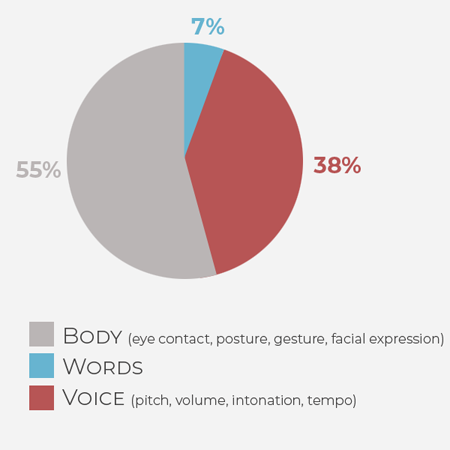
Speak with Your Style

History boasts many master speakers. For example, Mahatma Gandhi, who called for a passive but determined resistance against England’s rule of India in his “Quit India” speech, and Barack Obama, whose victory address to crowds in Chicago after his historic election is regarded as one of the most powerful speeches in modern politics. What makes them powerful speakers?
You can hear the speech that made Obama president here.
Speakers have unique ways to deliver their message to the audience. Directed by your purpose, you can develop your own style of public speaking. The key is to gracefully deliver a speech with confidence and charisma. The goal is to catch your audience’s attention and drive home your message.
You can learn more about speaking styles here.
Watch this source for a TED Talk given by Celeste Headlee, an award-winning journalist, author, and accomplished speaker, on how to have a better conversation.
What makes her stand out as a powerful speaker? What is her speaking style?
Try it!
Is this an appropriate opening for a business meeting? Why or why not? Consider whether the tone, language, and content match the speaker’s purpose.
I think we’ll begin now. First, I’d like to welcome you all and thank everyone for coming, especially at such short notice. I know you are all very busy, and it’s difficult to take time away from your daily tasks for meetings.
| TONE | LANGUAGE | CONTENT | |
|---|---|---|---|
| Appropriate or not? | |||
| Why? |
| TONE | LANGUAGE | CONTENT | |
|---|---|---|---|
| Appropriate or not? | Yes | Yes | Yes |
| Why? | Tone is conversational and amiable. | Word choice is suitable for daily conversation. Sentences are short and clear. | The speaker builds a good relationship with the audience. |
In this example of a job interview, Riley See introduces herself. Do you think she uses appropriate tone and language to demonstrate she’s a good fit for the job she is seeking? Does the content match her purpose? Why or why not?
“My name is Riley See. I’m a recent graduate from Ontario College of Art & Design University. I’ve been working at an art program with elementary children this summer, and I’m excited to find my first teaching position as an art teacher for the coming school year. I have created several original lesson plans that I look forward to implementing in my own classroom. I grew up in a family of teachers. It would be a joy for me to become a teacher.”
| TONE | LANGUAGE | CONTENT | |
|---|---|---|---|
| Appropriate or not? | |||
| Why? |
| TONE | LANGUAGE | CONTENT | |
|---|---|---|---|
| Appropriate or not? | Yes | Yes | Yes |
| Why | The tone is conversational and eager. | The words are simple and carry clear meaning. | Her speech is informative. All ideas stay on topic. |
You learned why public speaking is important, and the role of both verbal and non-verbal communication in public speaking. You also learned qualities of language (concise, accessible speech) and voice (style and tone) that help make speeches powerful and effective.
Foley, G. N., & Gentile, J. P. (2010, June). Nonverbal communication in psychotherapy. Psychiatry 7(6), 38–44. https://www.ncbi.nlm.nih.gov/pmc/articles/PMC2898840/
MasterClass. (2020, March 23). How to use the 7-38-55 rule to negotiate effectively. https://www.masterclass.com/articles/how-to-use-the-7-38-55-rule-to-negotiate-effectively#what-is-the-73855-rule
Mind Tools Content Team. (n.d.). Body language: Picking up and understanding nonverbal signals. https://www.mindtools.com/pages/article/Body_Language.htm#:~:text=It%20includes%20your%20posture%2C%20your,strength%20to%20your%20verbal%20messages
Montopoli, J. (2017, February 20). Public speaking anxiety and fear of brain freezes [Blog post]. National Social Anxiety Center. https://nationalsocialanxietycenter.com/2017/02/20/public-speaking-and-fear-of-brain-freezes/#:~:text=The%20fear%20of%20public%20speaking,about%2073%25%20of%20the%20population.
Newman, R. (October 8, 2019). 4 speaking styles you should master and how to stop using them at the wrong moment during a speech. https://medium.com/@richardnewmanspeaks/4-speaking-styles-you-should-master-and-how-to-stop-using-them-at-the-wrong-moment-during-a-speech-d260afdecaf9
Pellicano, M. (2017, December 19). 4 essential types of tone of voice in communication. https://mariapellicano.com/four-types-tone-of-voice-in-communication/
TED. (2016, March 8). 10 ways to have a better conversation [Video]. YouTube. https://www.youtube.com/watch?v=R1vskiVDwl4
TEDx Talks. (2014, November 5). The 7 secrets of the greatest speakers in history [Video]. YouTube. https://www.youtube.com/watch?v=i0a61wFaF8A
The Harvard Gazette. (2017, May 25). Mark Zuckerberg’s commencement address at Harvard. https://news.harvard.edu/gazette/story/2017/05/mark-zuckerbergs-speech-as-written-for-harvards-class-of-2017/
THNKR. (2012, August 30). The speech that made Obama president [Video]. YouTube. https://www.youtube.com/watch?v=OFPwDe22CoY
3 reasons why public speaking is important. (2014, July 24). PAN Communications. https://www.pancommunications.com/blog/3-reasons-why-public-speaking-is-important/#:~:text=It%20allows%20us%20to%20form,most%20dreaded%20forms%20of%20communication.
Tsaousides, T. (2017a, November 27). Why are we scared of public speaking? [Blog post]. Psychology Today. https://www.psychologytoday.com/ca/blog/smashing-the-brainblocks/201711/why-are-we-scared-public-speaking
Tsaousides, T. (2017b, November 28). How to conquer the fear of public speaking [Blog post]. Psychology Today. https://www.psychologytoday.com/ca/blog/smashing-the-brainblocks/201711/how-conquer-the-fear-public-speaking
Verbal communication skills. (n.d.). SkillsYouNeed. https://www.skillsyouneed.com/ips/verbal-communication.html
Audience Analysis
Audience analysis is a task performed at the early stages of preparing a public speech. A speaker needs to assess the audience to make sure the information provided to them is at the appropriate level.
What You’ll Learn:
- How to analyze the audience
- How to determine the purpose of your speech

Your audience’s needs determine your word choice and tone.
Before you give a speech, ask yourself: Who’s your audience? What’s the appropriate tone and mood? How do you achieve your purpose by responding to your audience’s needs?
Look at these two scenarios. Answer these questions: Who’s the audience? What language is used? What’s the tone? What does the audience expect?
“That patient is suffering from separation anxiety disorder. I’d like to try cognitive behavioural therapy.”
“It’s okay, sweetie. Don’t cry. Your mama will be back soon.”
(Engkent, 2011, p. 3)
In the first scenario, the audience is a specialist. Medical jargon is used to describe the patient’s symptoms and treatment. The tone is calm and professional. The audience wants to hear the doctor’s diagnosis.
In the second scenario, the audience is a child. Very simple language is used. The tone is comforting and reassuring. The audience wants to be assured that mother will come back soon.
If you don’t fully understand the first scenario, you’ll surely understand what’s happened to the patient after looking at the second scenario. The patient is a child who is crying because the mother is away.
How to Analyze the Audience
What’s audience analysis?
When you analyze your audience, you identify your audience members’ attitudes, beliefs, level of understanding, and interests to understand the world from their perspectives. This can help you determine the content of your speech, what language to use, and listener expectations. You can tailor your message to the needs of the listener to communicate more effectively.
Approaches to audience analysis
| DEFINITION | SCENARIO | |
|---|---|---|
| Situational Analysis | Consider the time and place of a speech, the audience size, and the speaking occasion. | Giving a talk in a meeting room with the capacity of 20 people or in an auditorium that holds 1,000 people means entirely different expectations for a speaker. Temperature, size of the room, the level of surrounding noise, time of day are some factors that influence the audience’s desire to listen. A speaker needs to find out these factors ahead of time to resolve these issues appropriately. |
| Demographic Analysis | “Whenever addressing an audience, it is generally a good idea to know about its age, gender, major, year in school, race, ethnicity, religion, et cetera” (DeCaro, Adams, & Jefferis, n.d.). Knowing these details, you can include useful and relevant information to engage your audience. | Talking to a group of 25–35 year olds about economic development after World War II is a different experience from talking about the same topic to a group of 55–65 year olds. People from the older group are more likely to feel connected to the topic. The speaker needs to include more background knowledge while addressing the younger audience. Alternatively, the speaker can ask the younger audience to do some research on the topic before the speech. |
| Psychological Analysis | Understand what beliefs and attitudes your audience already have regarding your topic. “It’s always important to know where your audience stands on the issues you plan to address ahead of time” (DeCaro, Adams, & Jefferis, n.d.). | Suppose you’re giving a talk about environmental protection to a group of economists. Very likely they hold the idea that a strong economy is key to human development. In this case, you may want to start your speech by providing facts and examples to prove that unsustainable economic growth is responsible for the depletion of natural resources, animal extinction, and excessive greenhouse gases. This can give you credibility and help you gain the trust of the audience. |
| Multicultural Analysis | Be aware of cultural differences. Become a culturally effective speaker. The capacity to appreciate other cultures can help you build common ground with audience members from diverse ethnic backgrounds. | Your topic may not be shared among other cultures. Avoid sensitive topics. Also, be careful with humour. It can be risky to tell jokes when you address a multicultural audience. What’s funny in one culture may be taboo or incomprehensible in another. |
| Topic Interest and Prior Knowledge | You need to know ahead what prior knowledge your audience has. You don’t want to present information that your audience already knows. You want to sound resourceful, knowledgeable, and confident. | If you are giving a talk on “Overcoming Cyber-Bullying” to parents, consider what they may already know about cyber-bullying and what they need to know to support and protect their children. You may want to define technical terms and concepts that aren’t mainstream such as “trolling” or “flaming.” You may avoid giving a history of the internet or defining social media because your audience is familiar with these things. |
You can learn more in this University of Pittsburgh page on Audience Analysis.
Try it!
Watch the TED Talk “You Don’t Find Happiness, You Create It” by Katarina Blom, a psychologist and the first author to publish a Swedish book on positive psychology. Pay attention to her tone, body language, word choice, sentence structure, and audience management.
Choose the better answers to the following questions.
Public Speaking Statistics
When a speaker does all the talking without giving the audience an opportunity to participate, audience engagement drops by 14%.
Adding facts and figures to a presentation increases audience retention by 20% (Allison, 2018).
Who is the audience of the speech?
What’s her speaking style?
What kind of language does she use to convey her message?
What’s her tone when she addresses the audience?
How does she use body language to convey her message?
Before you begin to draft your speech, it is important to analyze your audience to tailor your speech to their needs.
Analyzing the Audience
Situational analysis
Demographic analysis
Psychological analysis
Multicultural analysis
Topic interest and prior knowledge
Allison, K. (2018, March 30). 5 shocking public speaking statistics. Ethos3. https://www.ethos3.com/2018/03/5-shocking-public-speaking-statistics/
Audience analysis. (n.d.). Department of Communication, University of Pittsburgh. https://www.comm.pitt.edu/oral-comm-lab/audience-analysis#:~:text=Audience%20analysis%20involves%20identifying%20the,delivered%20in%20an%20appropriate%20manner.
Beall, J. (n.d.). General purpose of speaking. In Stand up, speak out: The practice and ethics of public speaking. University of Minnesota. https://open.lib.umn.edu/publicspeaking/chapter/6-1-general-purposes-of-speaking/
DeCaro, P., Adams, T., & Jefferis, B. (n.d.). Audience analysis [PDF]. http://publicspeakingproject.org/PDF%20Files/aud%20analy%20web%201.pdf
Engkent, L. (2011). Skill set with grammar. Toronto: Oxford University Press Canada.
General purpose vs. specific purpose of a speech. (n.d.). Study.com. https://study.com/academy/lesson/general-purpose-vs-specific-purpose-of-your-speech.html
TED. (2011, April 11). The history of our world in 18 minutes [Video]. YouTube. https://www.youtube.com/watch?v=yqc9zX04DXs
TED. (2016, February 1). This is what happens when you reply to a spam email [Video]. YouTube. https://www.youtube.com/watch?v=_QdPW8JrYzQ
TEDx Talks. (2018, May 7). You don’t find happiness, you create it [Video]. YouTube. https://www.youtube.com/watch?v=9DtcSCFwDdw
Winston Churchill Speeches. (2017, June 3). We shall never surrender speech by Winston Churchill (We shall fight on the beaches) [Video]. YouTube. https://www.youtube.com/watch?v=s_LncVnecLA
Persuade and Inform
In a public speech, speakers often attempt to convince the audience to agree with their opinion. To accomplish this, they provide strong and adequate information and use tools of persuasion.
What You’ll Learn:
- How to make your speech persuasive
- How to make your speech informative
Answer the following questions about how to give an effective speech.
What do you do when you choose ideas for your speech?
How do you organize ideas in a speech?
What do you do when you try to justify your points?
How do you open your speech?
How to Make Your Speech Persuasive
Keep your audience at the centre. If your audience has built up their own perspectives on your topic, you may want to provide strong and adequate evidence before stating your opinion. If your audience know very little about your topic, you might want to state your opinion at the beginning, then provide evidence for it.
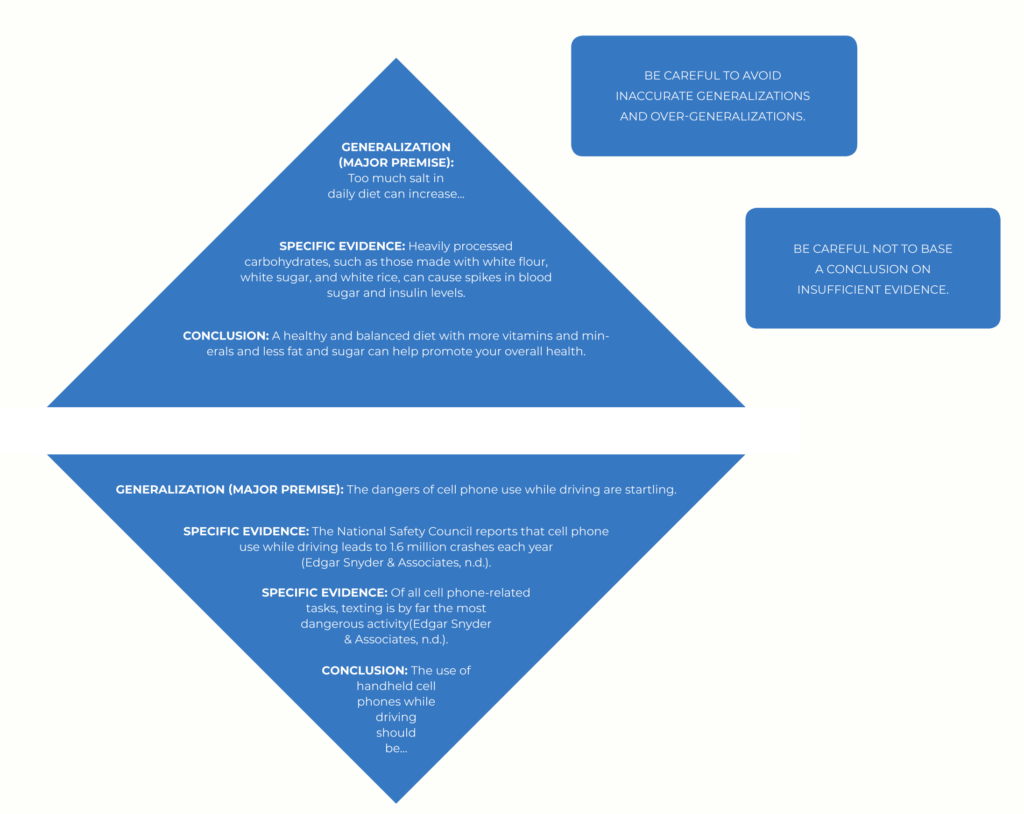
To persuade your audience, you need to give them ample attention. You should have direct and extended eye contact and pay attention to their reactions.
Audience-centred communication allows the speaker to tailor the message to the needs of their listeners.

How to Combat Short Attention Spans
• Give a surprising statement at the beginning of the speech.
• Include an anecdote or personal experience in the speech.
• Engage the audience with questions or activities.
• Do not linger over unimportant details.
• Use transition signals to lead the audience through your story.
• Use humour to make your audience laugh.
• Make slides image heavy, not text heavy.
Build credibility in your introduction
It’s essential to win trust from the audience at the beginning of your speech. For example, if you are giving a speech on the benefit of sports, you could use the following strategies in your opening.
| OPENING STRATEGIES | EXAMPLES |
|---|---|
| Reveal a personal connection to your topic. | Running a marathon has completely changed my life. I’ve learned to be resilient. Success doesn’t build character; failure does. |
| State your credentials. | I’m a marathon coach. I’ve won the Boston Marathon three times. Now I’m teaching people how to build resilience not only physically but also mentally. |
| Establish common ground with your audience. | Have you ever tried running a marathon but had to give up because it was too challenging to continue? I’ve been there. |
| Show your knowledge, experience, and insights. | I’ve been running marathons for 15 years. I started running to build my stamina, but then I realized it also enables me to achieve so many other things, such as social skills, confidence, and expression of emotions. |
Remember, you’re the message. Speak loudly, clearly, and confidently. Use your gestures and facial expressions to reinforce your credibility.
Learn more about establishing credibility here.
View the source for seven memorable ways to open a speech.
Choose the right persuasive approach
Aristotle proposed three argumentative appeals (three ways to persuade your audience): logical, ethical, and emotional. Strong arguments have a balance of all three.
Logical appeal is the strategic use of logic, claims, and evidence to convince an audience of a certain point.
Ethical appeal is used to establish the speaker as fair, open-minded, honest, and knowledgeable about the subject matter. If audience members believe the speaker is trustworthy and credible, they are more likely to be persuaded by the speaker’s points.
Emotional appeal targets the emotions of the audience to create some kind of connection with the speaker (“The Three Appeals of Argument,” n.d.).

Logical Appeal
(Reason/Proof)
Structured speech (opening/body/conclusion)
References to studies, statistics, case studies…
Use of comparison, analogies, metaphors…

Ethical Appeal
(Credibility/Trust)
Personal branding
Confidence in delivery
Cite credible sources

Emotional Appeal
(Emotion/Values)
Stories
Inspirational quotes
Vivid language
See more about the three appeals here.
Say a speech is about individual endeavours to stop and overcome environmental destruction.
| APPEALS | EXAMPLES |
|---|---|
| Logical Appeal | Our earth provides us with air, food, and many other needs. Humanity depends on a healthy and sustainable environment to carry on our daily activities. It is essential for us to protect the natural environment. |
| Ethical Appeal | The environment is deteriorating. I’ve spent the past 10 years studying how climate change has brought detrimental effects on our surroundings. David Attenborough, a British natural historian, says, “If we don’t take climate action, the collapse of our civilizations and the extinction of much of the natural world is on the horizon” (Katowice, 2018). |
| Emotional Appeal | Every day animals lose their homes when trees are chopped down. This makes them more vulnerable to predators and other dangerous conditions. If we become more aware of this serious issue and start to take protective action, we could save these beautiful forests and the animals who call them home. |
You can learn more about persuasive speaking here.
How to Make Your Speech Informative
Use lots of evidence

Examples serve as logical appeal. They help prove your point. They also serve as emotional appeal. Examples are more interesting to listen to than opinion or a long list of facts.
Evidence used in your speech needs to be credible. It can be facts and figures from respected authorities, charts and graphs, anecdotes, and personal experience.
A speaker talking about the valuable lesson learned from failure uses a variety of evidence to support their ideas in the following passage.
People always enjoy the moments of success and avoid the experience of failure without knowing the latter can be the catalyst for life-long development. While feeling successful brings pride and confidence, failure makes us feel lost and discouraged. In this success-driven society, failure is considered deficiency. However, failing doesn’t mean failure. Bill Gates, an American business magnate, says, “Success is a lousy teacher. It seduces smart people into thinking they can’t lose.” Failing can push people to reach their potential and help them gain new perspectives. Walt Disney was told he lacked creativity. Milton Hershey started three candy companies before Hershey’s and watched all of them fail. It is those who can’t lose who will fall victim to setbacks. If Thomas Edison could take 10,000 steps before the invention of the light bulb, why can’t we learn the lessons from failure and gain a real sense of achievement?
In this example, the speaker is quoting Bill Gates to support their ideas. The speaker also uses real-life examples to build common ground with the audience: While success can make us complacent, failure can inspire us to carry on.
Address the counterargument
This gives you a chance to address your audience’s possible objections and make your argument stronger.

You’re giving a talk on euthanasia- also known as medically assisted suicide. Your argument is that ending a loved one’s life in order to ease their pain should be allowed if the patient has consented. During the talk, you could address the opposing viewpoint: Allowing someone to murder another living human is illegal. Then, provide strong and adequate evidence to prove this argument isn’t valid in this case.
Including a counterargument in your speech shows you know and understand that other positions exist, you’ve considered those, and you can respond to them. Doing this gives you credibility and can strengthen your argument.
You can learn more about counterarguments here.
Conclude with a call to action

If you add a call to action at the end of your speech, you tell your audience the role they can play after they leave your talk. It gives an audience concrete tasks to tackle, which helps bring your ideas to life.
If your talk is about charitable work, you could ask your audience to donate to a charity at the end of your speech. If your talk is about the importance of a balanced diet, you could urge your audience to eat more vegetables. If your talk is about how running can help strengthen the immune system, you could encourage your audience to train for an upcoming marathon.
Now you’ve learned how to make your speech persuasive and informative. When you draft your speech, remember to use some of these strategies to make it more engaging and effective.
Try It!
Watch the TED Talk by Brian Little, an internationally acclaimed scholar and speaker in the field of personality and motivational psychology.
Strong speakers use strategies to win over the audience. Match what Dr. Little does in the speech in column B with the strategies in column A.
We explored how to make speeches persuasive and informative. Persuasive speeches are audience-centred and use strategies to increase the speaker’s credibility. Informative speeches rely on evidence and counterarguments. We learned that speeches often end with a call to action.
Ashman, M. (2018, June 13). Persuasive appeals. In Introduction to professional communications. https://pressbooks.bccampus.ca/professionalcomms/chapter/5-6-persuasive-appeals/
Edgar Snyder & Associates. (n.d.). Texting and driving accidents statistics. https://www.edgarsnyder.com/car-accident/cause-of-accident/cell-phone/cell-phone-statistics.html#:~:text=The%20National%20Safety%20Council%20reports,caused%20by%20texting%20and%20driving.
Establishing credibility. (n.d.). https://lumen.instructure.com/courses/218897/pages/linkedtext54231?module_item_id=5007088
Harvey, G. (1999). Counterargument. Harvard College Writing Center. https://writingcenter.fas.harvard.edu/pages/counter-argument#:~:text=Counterargument,some%20aspect%20of%20your%20reasoning.
Introduction to persuasive speaking. (n.d.). Boundless communication. Lumen Learning. https://courses.lumenlearning.com/boundless-communications/chapter/introduction-to-persuasive-speaking/
Katowice. (2018, December 3). David Attenborough warns of extinction, collapse of civilization at COP24. Agencia EFE. https://www.efe.com/efe/english/technology/david-attenborough-warns-of-extinction-collapse-civilization-at-cop24/50000267-3831634#:~:text=%22If%20we%20don’t%20take,the%20horizon%2C%22%20Attenborough%20added.
Peterson, J. B. (2018). 12 rules for life: An antidote to chaos. Toronto: Random House Canada.
Phillips, B. (2019, April 26). How many minutes is the audience’s attention span? [Blog post]. The Throughline Blog. https://www.throughlinegroup.com/2012/08/23/how-many-minutes-is-the-audiences-attention-span/
7 memorable ways to open a speech or presentation. (n.d.). YPO. https://www.ypo.org/2015/04/7-memorable-ways-to-open-a-speech-or-presentation/
TED. (2016, July 19). Who are you, really? The puzzle of personality [Video]. YouTube. https://www.youtube.com/watch?v=qYvXk_bqlBk
The three appeals of argument [PDF]. (n.d.). University Writing Center. https://uwc.cah.ucf.edu/wp-content/uploads/sites/9/2015/04/Three_Appeals_Argument.pdf
Drafting a Speech
Preparing a preliminary version of a speech creates a solid foundation for what you want to address and focus on in your speech.
What You’ll Learn:
- How to pick ideas and impress the audience
- How to organize ideas
- How to choose a language style
If you want to give a speech on e-learning, what main points would you include?
All about E-Learning
| CAUSES | ADVANTAGES | DISADVANTAGES | SOLUTIONS TO POTENTIAL PROBLEMS |
|---|---|---|---|
| • Technological development
• Saves cost and time • Higher level of accessibility | • Convenient
• Efficient • Inclusive • Flexible • Affordable | • Social isolation
• Limited feedback • Lack of communication skill development • Lack of face-to-face communication • Requires strong time management skills | • Create awareness about e-learning
• Set clear objectives for learners • Stimulate learner’s curiosity • Create effective assessments |
Talking about all these points in your speech is not effective. You want to avoid “all-about” speeches; try to focus on one aspect of a topic instead.
How to Pick Ideas and Impress the Audience

| FOCUS ON ONE OR TWO IDEAS | CREATE A MEMORABLE PHRASE | |
|---|---|---|
| Why | Do not try to put too many ideas into your speech. The audience will likely recall only three points from your presentation (“Presentation Skills 3: The Rule of Three,” 2009). | Clearly state your main argument and provide a memorable phrase. This can help you reinforce the ideas throughout your speech. |
| How | For the e-learning topic, you could discuss problems created by online education and try to come up with solutions. Or you could address the differences between e-learning and in-class learning.
Watch the first two minutes of this TED talk here and consider the following questions. What are the main ideas of the talk? What topics related to happiness will not be addressed in this talk? | The phrase “I have a dream” is repeated throughout Martin Luther King’s “I have a dream” speech, which created a great impact on the audience.
In Mark Zuckerberg’s Harvard commencement address, he states at the beginning, “I’m here to tell you finding your purpose isn’t enough. The challenge for our generation is creating a world where everyone has a sense of purpose” (Harvard University, 2017). He returns to this message—that we need to make a difference in the world, not just in our own lives—throughout the speech. You can see Mark Zuckerberg’s full address here. |
How to Organize Ideas
Have a structure
A disorganized speech will cause your audience to lose interest. In his article “10 Keys to Writing a Speech,” Jeff Schmitt (2013) says, “Audiences expect two things from a speaker: A path and a destination. They want to know where you’re going and why.”
Split your speech into three sections: introduction, main body, and conclusion.
| STRUCTURE OF A SPEECH | |
|---|---|
| Introduction | Your aim is to tell your audience who you are and what you’re talking about. You want to grab their attention. |
| Body | You make your argument. Divide the main body into 2–3 points and use adequate and reliable examples to support these points. |
| Conclusion | A good conclusion summarizes what you said and reinforces the main arguments. |
See more on how to structure a speech here.
Make an impressive opening statement
Your audience will be most receptive at the beginning of your speech.
Design an engaging introduction. You can share a shocking fact or statistic. You can tell a humorous anecdote related to your core message. You can open with a question and have your audience raise their hands. Get your listeners engaged early.



Techniques to Open a Speech
| AN ANECDOTE | A SURPRISING STATEMENT | A CONTRAST |
|---|---|---|
| An anecdote is a short, interesting story about a person or an incident. Use it to intrigue an audience at the beginning of your speech. | “Surprise is a powerful tool in any speech. It makes your audience sit up and pay attention” (Ogahara, 2019). Think of the most surprising opinion or fact you want to convey in your speech and use it right at the beginning. | You can start your speech with a contrast that is relevant to your topic. You can make the audience think by creating images in their minds. |
| I’m here to talk to you about how to reduce stress in our daily life. Mark Zuckerberg, CEO of Facebook, wears the same T-shirt every day. The reason is that he wants to focus on more important decisions at work. Why? Small decisions such as what to eat or wear can consume our energy and make us mentally fatigued. | We are experiencing a biodiversity crisis. The rapid loss of species we’re seeing today is estimated by experts to be between 1,000 and 10,000 times higher than the natural extinction rate. | Thirty years ago, we had to leave home to do many things. We went to the library to borrow books and restaurants to enjoy a meal. Now, all these can be done on the internet. Many services are available at the click of a mouse. Technology has revolutionized our life. |
Watch the first three minutes of the TED Talk “Searching for Love to Escape Ourselves.” How does the speaker Hayley Quinn start her talk?
Learn more ways to start your speech here.
End strong
Your ending note is what your audience will remember. So add your biggest takeaway. Tie everything together. Share a success story. Make a call to action.
In the TED Talk “Programming Your Mind for Success,” Carrie Green, founder of the Female Entrepreneur Association, argues that fear, obstacles, and lack of motivation prevent people from achieving their goals. At the end of the speech, she calls on people to remember their purpose in life and take action to make their dreams come true.
Keep it short
Remember your audience’s attention will naturally disappear after seven minutes. The longer you stay on the stage, the more likely you are to stray or make mistakes. Therefore, cut unnecessary words. Keep your speech short.

A study by Harvard psychologists Matthew Killingsworth and Daniel Gilbert found that 46.9 percent of waking hours are spent thinking about what isn’t going on (Bradt, 2010).
How to Choose Language Style
Set the right tone
Given your purpose and the audience’s needs, choose an appropriate tone for your speech. You want to sound trustworthy, confident, and resourceful. Be careful with humour. Appropriate use of humour can attract interest, but inappropriate jokes can distract from your goal.
Simplify your speech
Remove anything confusing and contradictory.
In this TED Talk “The Psychology of Self-Motivation,” Scott Geller, a behavioural psychologist, sets a very clear goal at the beginning of the talk and uses simple language to walk the audience through the talk.
Use conversational language


“Remember that you’re writing a speech, not an essay. People will hear the speech, not read it. The more conversational you can make it sound, the better” (“Tips from the Pros,” n.d.). Having a heartfelt conversation with your audience can bring your speech to life.
Now look at the differences between conversational language and written language.
| Conversational Language | Written Language |
|---|---|
| Use short sentences | Use more complex sentences |
| Use contractions | Avoid contractions |
| Don’t use big words that you wouldn’t use when talking to people | Use academic words to communicate ideas |
| Don’t have to follow all the rules of written English grammar | Follow written English grammar rules |
| Write in the first person and engage your audience | Always try to write in the third person to stay objective |
| Always read your speech aloud when you’re writing it | Reading aloud while writing an essay may disrupt your thoughts |
In an essay about writing, you may write: “Strong writers are not always eloquent speakers. My passion for writing dates back to my middle-school years. Writing short stories in the old library in my school is one of my fondest memories.”
In a speech about writing, you may say: “I was never a good public speaker. But writing? My school’s old rundown library is where I found my true calling.”
Use contrast
Contrast brings flavour to your figurative language. It highlights your points because it creates a clash of imagery in your audience’s mind.
For example, you may say, “I love music, but I hate loud and noisy music.” Or you could describe one person as “fiery and passionate” and another as “cold-hearted.”
Use repetition
In a speech, repetition leaves an impression. Emphasize keywords, phrases, and themes. Always try to reinforce earlier points and repeat critical points.
If you start your speech by saying, “Silence is gold,” repeat that phrase in the conclusion to your speech.
Use transitions
Use transition words and phrases to signal important points.
“Likewise” and “however” indicate comparison and contrast. When you say, “What does this mean?” and follow it with a pause, you will get attention from the audience. When you say, “So here is the lesson,” you highlight that what you are about to say is important.
Use concrete words and examples
Concrete language can help you send your message to the audience quickly. Concrete words refer to things that we know through our senses. “If a word is concrete, you will know which of the five senses it appeals to. Does it appeal to sight, smell, touch, taste, or hearing? This kind of description is often more useful to readers because it offers more vivid details” (Hill, 2017).

ABSTRACT LANGUAGE
The views in Banff National Park are wonderful.
CONCRETE LANGUAGE
Banff National Park’s towering peaks and flower-strewn meadows make it one of the most popular holiday areas in Canada.
The word “wonderful” is abstract. It does not evoke the experience of being in the park. The use of the concrete words “towering” and “flower-strewn” creates a sensory experience, so your audience visualize the high mountains and colourful grassland.
Now, you’ve got a draft of your speech. Rehearsing and preparing to deliver your speech will be the next steps.
Try it!
Watch the TED Talk “Power Foods for the Brain.”
In his talk, Neal Barnard, professor of medicine at the George Washington University School of Medicine, lists some food that is healthy for our brains.
Choose the correct answers for the following questions.
How does he start his talk?
How does he organize ideas in the talk?
How does he end the talk?
What language style does he use in the talk?
We explored how to draft a speech by focusing and structuring ideas, and by using appropriate language. It’s important to zero in on a limited set of ideas in most speeches, and to have a strong sense of beginning, middle, and end. Language can be used to attract listeners and reinforce ideas—for example, figurative language, contrast, and repetition.
Bradt, S. (2010, November 11). Wandering mind not a happy mind. The Harvard Gazette. https://news.harvard.edu/gazette/story/2010/11/wandering-mind-not-a-happy-mind/
Harvard University. (2017, May 25). Facebook founder Mark Zuckerberg commencement address/Harvard Commencement 2017 [Video]. YouTube. https://www.youtube.com/watch?v=BmYv8XGl-YU
Hill, J. (2017). Abstract vs. concrete language [PDF file]. https://www.mscc.edu/documents/writingcenter/concrete-vs-abstract-language.pdf
Literary Devices. (n.d.). Figurative language. https://literarydevices.net/figurative-language/#:~:text=Figurative%20language%20uses%20figures%20of,to%20give%20readers%20new%20insights
Ogahara, H. (2019, May 1). How to write a speech. https://www.lovelearningtutors.com/main-blog/2018/4/30/how-to-write-a-speech-english-gcse-exam
Presentation skills 3: The rule of three. (2009, April 20). Presentation Magazine. https://www.presentationmagazine.com/presentation-skills-3-the-rule-of-three-7283.htm#:~:text=1.,three%20things%20from%20your%20presentation.
Schmitt, J. (2013, July 16). 10 keys to writing a speech. Forbes. https://www.forbes.com/sites/jeffschmitt/2013/07/16/10-keys-to-writing-a-speech/#23cf55e44fb7.
Structuring the speech. (n.d.). Department of Communication. University of Pittsburgh. https://www.comm.pitt.edu/structuring-speech
TED. (2017, September 26). There’s more to life than being happy [Video]. YouTube. https://www.youtube.com/watch?v=y9Trdafp83U&list=PL1RvFZ7BdABcQW0KE8z3brVIwbuH5hlQO&index=6
TEDx Talks. (2014, June 20). Programming your mind for success [Video]. YouTube. https://www.youtube.com/watch?v=MmfikLimeQ8
TEDx Talks. (2016, February 12). Searching for love to escape ourselves [Video]. YouTube. https://www.youtube.com/watch?v=jmUayKnHWWM
TEDx Talks. (2016, September 20). Power foods for the brain [Video]. YouTube. https://www.youtube.com/watch?v=v_ONFix_e4k
Tips from the pros. (n.d.). Scholastic. http://teacher.scholastic.com/writewit/speech/tips.htm
Tracy, B. (n.d.). 15 ways to start a speech + bonus tips. https://www.briantracy.com/blog/public-speaking/how-to-start-a-speech/
Presentation Tools and Software
Presentation tools and software make it possible for us to create and experience engaging presentations.
What You’ll Learn:
- How to use software for your presentation
- How to give a synchronous virtual presentation
- How to give an asynchronous virtual presentation
Complete the following poll.
I’m very confident using technology to present.
I’ve used different tools, such as PowerPoint, Prezi, and Google Slides, to present.
I like to include animation on presentation slides because it engages the audience more.
I usually include only key points on presentation slides.
I always create colourful slides to attract the audience’s attention.
I don’t like to use video during virtual conferencing.
I often try to raise an open-ended question at the end of my presentation for the audience to discuss.
At the end of this subtopic, we’ll come back to look at some of your answers.
How to Use Software for a Presentation
Some advantages to using presentation software include:
| Quick and Engaging Design | Easy and Inclusive Delivery |
|---|---|
| Simple bullet points | Easier to be seen by a large audience |
| Easy to create a colourful and attractive design | Easy to present |
| Easy to modify content | Easy to build a connection |
| Easy to re-organize presentation | No need for handouts |
One of the most popular and commonly used presentation formats is PowerPoint. In PowerPoint, you can combine text, graphics, and multimedia content to create a professional presentation.
You can also use alternative presentation formats such as Prezi, Vyond, Google Slides, Haiku Deck, and so on.
Visual aids can help you emphasize main ideas, illustrate a concept, or stimulate the interest of your listeners. However, misuse or overuse of visual aids can cause a negative impact. When you create a slideshow for your presentation, you want to keep the following principles in mind.
Emphasize important points and add interest to your presentation
The following slide includes very short and concise key points that the speaker wants to communicate to the audience.
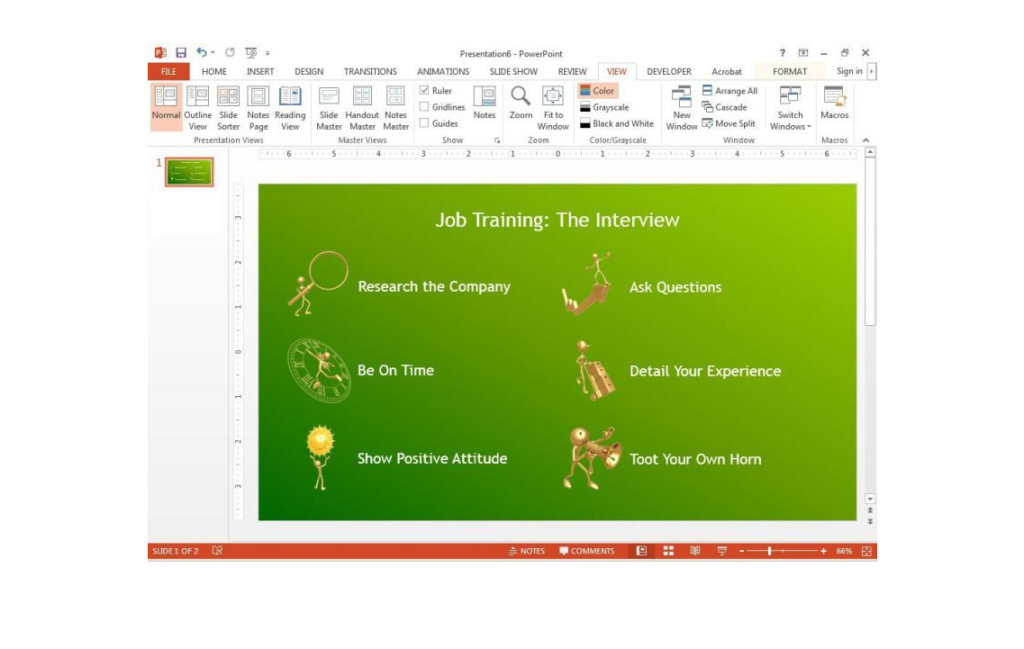
Give the visuals a consistent appearance
Apply the same colour and spacing for all slides. For example, the following slides use black background to show the mystery of space and all slides are consistent.

Minimize the text
Make sure the slides are image heavy with minimum amount of text. If you present on tree plantation, here is a very simple image that sends a powerful message.

Avoid putting too much information on a slide. The audience will be reading the slide rather than listening to you.
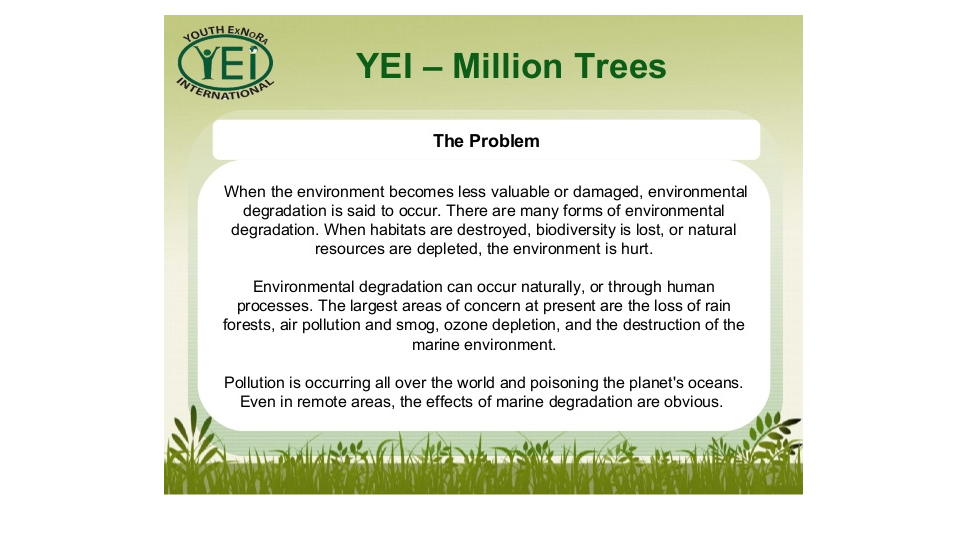
Make sure the text is large enough for people to read
If you have a large audience, make sure all the audience can see the text on your slides.
Don’t read the text that’s on the visual aid, but do paraphrase and add to it. Reading from slides reduces the interaction between the speaker and the audience. When you read text on the slides, you’re not looking at your audience.
Finally, keep your slides simple and clear by:
- Using minimal design and content
- Avoiding distracting images
- Avoiding acronyms
- Avoiding logos
| Common Mistakes in Slideshow Presentations | |
|---|---|
| Distracting transitions and sound effects | “Transitions and sound effects can become the focus of attention, which in turn distracts the audience” (Sommerville, 2017). Avoid using them and focus on your topic. |
| Bad clipart | Poor clipart may bore the audience. Use your own photos or better-quality graphics from companies such as Flickr (flickr.com) or Imgur (imgur.com). |
| Overused templates | Create your own style. Keep your slides clean and simple. Minimalism helps your audience focus on the content. |
| Text-heavy slides | Keep text to a minimum. Avoid sentences. Use bullet points and keywords. |
| Bad choice of size | Ensure text and images on slides are large enough to be seen easily by your audience. |
| Reading from slides | Do not read from your slides. Know your presentation well and be able to talk casually. |
| Faith in technology | Malfunction of technology can ruin your presentation. “Always familiarize yourself with the presentation, practice it and be ready to engage the audience regardless of the technology that’s available” (Sommerville, 2017). |
The 10/20/30 Rule of PowerPoint
The most effective PowerPoint presentations should contain no more than 10 slides, last no longer than 20 minutes, and feature font no smaller than 30 points (Jonson, 2016).
Here are some tips for making effective PowerPoint presentations.
How to Give a Synchronous Virtual Presentation

A synchronous virtual presentation takes place live using video conferencing software. Given that virtual conferencing is now a typical part of professional life, it’s important to think about how to present effectively in this medium.
| What You Need to Do as a Presenter | |
|---|---|
| Use video and be visible | Technology such as Zoom, Skype, and Microsoft Teams helps recreate the atmosphere of an in-person meeting. Seeing each other’s facial expressions and body language can improve engagement. |
| Test the technology ahead of time | The presenter should test the microphone, screen sharing, and camera 5–10 minutes before going live (Yarbrough, 2020). Check lighting to ensure the video feed is clear. |
| Eliminate distractions | Before you share your screen, make sure you have the content you want to present prepared. Make sure your slides are relevant and tailored to the room. Ask participants to mute their microphones if they’re not presenting. |
| Build rapport | Using an icebreaker can help to create a vibe of authentic communication. |
| Set clear objectives | Use an agenda and outline next steps at the end of the presentation. |
| Be succinct | Be mindful of the time and maintain your audience’s attention by focusing on your main point and avoiding digression. |
| Plan interaction to engage the audience | Use visuals, Q&A, questions, and polls to create audience engagement. |
Learn more effective ways to keep your audience engaged in an online presentation here.
| What You Need to Do as an Audience Member | |
|---|---|
| Minimize technical problems | Virtual presentations can be plagued by poor video and audio quality. Check your equipment ahead of the presentation. |
| Minimize distractions | In-person presentations allow for controlled environments. Virtual presentations, on the other hand, aren’t as controlled, so try to stay focused and listen to the presenter. |
| Ask well-thought-out questions | Take notes. Ask questions to increase your knowledge and show the presenter that you are listening. |
How to Give an Asynchronous Virtual Presentation
In an asynchronous virtual presentation, the presenter and the audience engage with the presentation at different times. The presenter records the presentation and uploads it online so the audience can access it later. While synchronous presentations enable more effective interaction, asynchronous virtual presentations allow the participants to re-watch the recorded presentation to deepen their understanding.
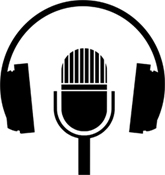
How to add voiceover to PowerPoint presentations
When you use PowerPoint tools to record your voice over the slides, the audio file is put within PowerPoint. This makes it easy to play your presentation on any device.
Learn how to do a voiceover on PowerPoint here.
Try it!
Now let’s look at your answers to the questions in the engagement activity.
If your answer is yes, great! Presenting confidently in public is an essential skill.
If your answer is no, keep practising. Strong presentation skills will bring you more opportunities.
Try different presentation tools. Each one has its own unique features.
This isn’t the best idea. Including animation on slides can be distracting.
Good idea! Your audience are there to listen to you, not to read your slides.
You may want to think twice. Too many colours can distract the audience.
Making your face visible during virtual conferencing can create a more authentic environment for communication.
Good idea! Involving the audience in your presentation makes the audience concentrate and think.
Now let’s look at a few scenarios. How would you solve the following problems during a presentation?
Presenters have a choice of presentation formats to deliver their points through well-designed slides. Virtual presentations allow individuals to present online without having to gather at the same location. These presentations can be either synchronous or asynchronous.
Frisch, B. (2020, March 5). What it takes to run a great virtual meeting. Harvard Business Review. https://hbr.org/2020/03/what-it-takes-to-run-a-great-virtual-meeting
Hansen, J. (n.d.). 10 ways to keep your audience engaged during an online presentation. Visme. https://visme.co/blog/engage-audience-online-presentation/
Jonson, L. (2016, January 13). The 10/20/30 rule of PowerPoint: Does it still work? https://blog.slideshare.net/2016/01/13/the-102030-rule-of-powerpoint-does-it-still-work
Record a slide show with narration and slide timings. (n.d.). Microsoft. https://support.office.com/en-us/article/record-a-slide-show-with-narration-and-slide-timings-0b9502c6-5f6c-40ae-b1e7-e47d8741161c
Tips for making effective PowerPoint presentations. (2017, August 8). National Conference of State Legislatures. https://www.ncsl.org/legislators-staff/legislative-staff/legislative-staff-coordinating-committee/tips-for-making-effective-powerpoint-presentations.aspx
Sommerville, J. (2017, August 8). The seven deadly sins of PowerPoint presentations. National Conference of State Legislatures. https://www.ncsl.org/legislators-staff/legislative-staff/legislative-staff-coordinating-committee/tips-for-making-effective-powerpoint-presentations.aspx
Yarbrough, J. (2020, April 20). How to give a virtual presentation: Tips, challenges, and more. https://www.lifesize.com/en/video-conferencing-blog/virtual-presentation-tips
Practise and Rehearse
Rehearse your presentation to increase your confidence, familiarize yourself with your material, and polish your delivery.
What You’ll Learn:
- Why rehearsal helps
- How to rehearse effectively
What do you do when you prepare for an important job interview?
I try to be familiar with the interview questions and answers, so I can be more fluent.
I try to sound confident and professional.
I make sure my voice is loud enough to be heard by the interviewers.
I practise the structure of my answers, so I sound logical and knowledgeable.
I rehearse in front of a mirror to practise eye contact and body language.
Preparing for a job interview can help you get the job. Preparing for a presentation can help ensure you deliver your message confidently and effectively.
Why Rehearsal Helps
In his book Outliers: The Story of Success, Malcolm Gladwell (2008) states that 10,000 hours of dedicated practice in your particular field is sufficient to make you an expert or master performer. In other words, we build expertise through practice.
Practising your speech will help ensure smooth, fluent, confident delivery.
Rehearse to improve fluency—to reduce/eliminate unnecessary content
When we are nervous, distracted, or at a loss for what comes next, it is easy to lean on filler words such as “um,” “ah,” and “you know.” However, if we start to overuse them, they can diminish our credibility and distract from our message.
Try the following tips to stay away from fillers.

Steve Jobs was a master presenter. According to the book Becoming Steve Jobs, “Steve would rehearse endlessly” (Schlender & Tetzeli, 2016).



| How to Reduce Fillers | |
|---|---|
| Get comfortable with silence (Communication Coach Alex Lyon, 2017) | Pause to create silence moment to make the audience think. |
| Develop a new habit during practice (Communication Coach Alex Lyon, 2017) | Practise out loud to hear the fillers and eliminate them |
| Record your rehearsal | Count how many filler words you include to become aware of them |
| Practise in a formal setting | Get feedback from your listeners |
Look at more ideas to reduce fillers here.
Rehearse to use tone and stress to emphasize, and to reduce monotone
As mentioned before, tone of voice and stress on certain words can serve as signposts for your audience. Use them to engage your audience and enhance your message.
Avoid monotone, which can cause your audience to lose interest.
| How to Get Rid of Monotone | ||
|---|---|---|
| Tone of Voice | Our tone of voice shows our concern for the audience. A monotone speaker can come across as boring even if the content is stimulating. | Speak loudly to grab the audience’s attention and drive your message home. Speak softly to engage the audience. Whispering and lowering your voice makes the audience think there is a secret being told. |
| Stress | Stress certain words. When you stress the right words in your presentation, it helps you get your points across with impact. | You can slow down your voice and emphasize the point or sentence you want to get across. Say it slowly to engage the audience. |
| Pace | An appropriate pace can give your speech rhythm and allow the audience to follow attentively. | Speaking too fast or too slowly will cause you to lose your audience. Slow down to engage the audience. Pause to allow your audience to think. |
Look at more ideas how to reduce monotone here.
Rehearse to build rapport—to make an emotional connection with the audience
By appealing to emotion, your speech can strike a sympathetic chord among your listeners.

There are many ways to use emotion in your presentation.
| How to Use Emotional Appeal | ||
|---|---|---|
| Tell a story | Storytelling is a powerful tool that sparks emotion, excitement, and anticipation while connecting to your audience and revealing something about yourself. | In the TED Talk “The Skill of Humor,” Andrew Tarvin starts with a story about his grandmother and himself. By telling a story, he successfully sends his message to the audience. Watch it here. |
| Describe a scene or a character | You can also describe a scene or a character that your audience relates to. Ask them to share their thoughts and experiences. | In the TED Talk “The Power of Zero Tolerance,” Isabelle Mercier mentions a state of mind that can kill creativity, performance, and dreams. The audience can closely relate to this situation: Many people worry about something every day. Watch it here. |
| Use humour, compassion, and empathy | Laughter is contagious. Use humour to entertain your audience by telling a joke or anecdote. Or inspire compassion in your audience by sharing personal experiences. | In the TED Talk “The Life-changing Power of Word,” Kristin Rivas, a hypnotherapist, recounts her journey from crippling mental illness following the death of her sister to healing and liberation. She manages to win compassion from the audience and make them feel her pain and joy. Watch it here. |
| Ask the right questions to make your audience think | Is there a hot topic that your audience wants to hear your opinion on? Raise a question on the topic and ask them to share their opinions. Encourage healthy debate. | In the TED Talk “After Watching This, Your Brain Will Not Be the Same,” Lara Boyd starts her talk with a couple of questions that everyone closely relates to: How do we learn? Why do some of us learn things more easily than others? Watch it here. |
Rehearse
Knowing your presentation thoroughly will help you rehearse to improvise if something doesn’t go according to plan, for example, if you are interrupted or face technological issues.
Rehearse to stay calm and confident
The more familiar you are with your material, the calmer and more confident you will be when delivering your speech.
How to Rehearse Effectively
(Information in this section adapted from “Rehearse Your Presentation,” n.d.)

Rehearse by yourself and with others
Record your rehearsal, so you can make adjustments. Then, rehearse to your friend or colleague and ask them for advice.
Time yourself
Reduce repetition and unnecessary details if necessary to finish speaking within your time limit.
Practise with your slideshow
Rehearse your talk using the visual aids you plan to use in your presentation. Make sure your speech is in line with your slides. Speak at a good pace, not too fast or too slowly. Ensure you don’t have too few or too many slides for the information you want to cover.
Look at more tips for rehearsing a presentation here.
You may also want to use a rehearsal tool to help you rehearse.
Try it!
Watch this TED Talk by Emily Esfahani Smith and give comments on the following aspects of the speech. The first comment is given as an example. Then compare your answers to the model.
| Comments | |
|---|---|
| Tone of voice | The speaker sounds calm and confident. |
| Familiarity with content | |
| Pace | |
| Word stress | |
| Audience engagement | |
| Connection with the audience |
| Comments | |
|---|---|
| Tone of voice | The speaker sounds calm and confident. |
| Familiarity with content | She is familiar with the content of her speech. There is no filler in her speech. |
| Pace | The speaker has a good pace. She speaks neither too fast nor too slowly. |
| Word stress | She pauses sometimes to make the audience think. |
| Audience engagement | She raises questions for the audience to think: Is there more to life than being happy? What’s the difference between being happy and having meaning in life? |
| Connection with the audience | The speaker starts with a personal note and a surprising statement: Chasing happiness makes people unhappy. |
Rehearsal is key step to giving a presentation. Rehearse with your visual aids to ensure you are prepared to deliver your speech.
Communication Coach Alex Lyon. (2017, June 12). How to avoid filler words [Video]. YouTube. https://www.youtube.com/watch?v=hUY8DiQgUUg
GCFLearnFree.org. (2014, January 24). PowerPoint2013: Rehearsing and recording [Video]. YouTube. https://www.youtube.com/watch?v=-9on8c2K9Q4
Gladwell, M. (2008). Outliers: The story of success. New York City: Little, Brown and Company.
Morgan, N. (2012, March 8). When is rehearsing a presentation a bad idea? Forbes. https://www.forbes.com/sites/nickmorgan/2012/03/08/when-is-rehearsing-a-presentation-a-bad-idea/#348438f2bb69
Rehearse your presentation. (n.d.). UNSW Sydney. https://student.unsw.edu.au/rehearse-your-presentation#:~:text=Rehearsal%20is%20essential%20to%20giving,to%20polish%20your%20presentation%20skills.&text=Rehearse%20your%20presentation%20to%20yourself,to%20a%20friend%20or%20colleague
Schlender, B., & Tetzeli, R. (2016). Becoming Steve Jobs: The evolution of a reckless upstart into a visionary leader. New York City: The Crown Publishing Group.
TED. (2017, September 26). There’s more to life than being happy [Video]. YouTube. https://youtu.be/y9Trdafp83U
TEDx Talks. (2014, January 13). The life-changing power of words: Kristin Rivas at TEDxRainier [Video]. YouTube. https://www.youtube.com/watch?v=joj7_brYWt8&t=385s
TEDx Talks. (2015, December 15). After watching this, your brain will not be the same [Video]. YouTube. https://youtu.be/LNHBMFCzznE
TEDx Talks. (2016, June 14). The power of zero tolerance [Video]. YouTube. https://www.youtube.com/watch?v=–mY5ruEhqI&t=516s
TEDx Talks. (2017, June 13). The skill of humor [Video]. YouTube. https://youtu.be/MdZAMSyn_As
Toastmasters International. (2013, July 3). Rehearsal tips for great speeches [Video]. YouTube. https://www.youtube.com/watch?v=HfRJg_4Xqkw
Ways to rehearse your speech for an effective presentation. (n.d.). Universal Class. https://www.universalclass.com/articles/business/rehearsing-your-speech-for-an-effective-presentation.htm
Ward, S. (2019, June 25). How to pep up your tired voice. The Balance Small Business. https://www.thebalancesmb.com/enthusiasm-and-monotones-dont-mix-2948545
Delivery
Make an impact on your audience with a well-written presentation that is lively and interesting.
What You’ll Learn:
- How to communicate in a presentation
- How to use visual aids to enhance your message
- How to dress for a presentation
- What role the audience plays in a presentation
Now it’s your time to get on the stage and use your charisma and knowledge to make an impact. But will your presentation proceed as you expected?
Watch this video presented by students from Stanford Graduate School of Business on how to use body language to win over your audience during your presentation. In this subtopic, we will discuss other important aspects to pay attention to while giving a presentation.
Presentations
Techniques for building the delivery
To maximize the effectiveness of your presentation, pay attention to the following tips.

| USE OF WORDS IN A SPEECH | ||
|---|---|---|
| Start with an anecdote | Sharing an interesting anecdote can be one way to grab the reader’s attention. | In TED talk
Learning a language? Speak it like you’re playing a video game, Marianna Pascal starts her talk with her personal experience as an ESL teacher in Malaysia. Watch it here.
|
| Build a conversation | A presentation is a two-way interaction, so find ways to interact with the audience if you can whether it be through Q&A or tone of delivery. | Estelle Gibson, in her TED talk,
The true cost of financial dependence, uses conversational style while narrating her experience to give the audience a chance to think through the talk. Watch it here.
|
| Simplicity | Keep the length of your presentation appropriate to your audience and purpose. | Bill Gates, in his TED talk
The next outbreak? We’re not ready, In spite of the complexity of the issue, makes his speech very easy to understand. Watch it here.
|
Tone of Voice
Andy Eklund (2012) says, “Tone vocalizes what the speaker is feeling. A positive tone might be described as ‘friendly’ or ‘confident,’ while a negative tone might be ‘bored’ or ‘dreadful.’” Use a speaking voice that is conversational, warm, and positive.

| USE OF VOICE IN A SPEECH | |
|---|---|
| Project your voice | Project your voice, so the person sitting farthest from you can hear you easily. |
| Vary your tone | Vary your tone to maintain interest and emphasize key points. |
| Alter pace | Maintain interest and add emphasis by giving your speech a rhythm. “Speak faster to show excitement and/or build suspense. Speak slower to show the importance of an idea. Pause after important ideas to allow audience time to grasp them” (“Delivering the Presentation,” n.d.). |
Body Language
Body language is extremely important. It provides non-verbal cues to the audience. Use these tips to make an impact right from the beginning of your presentation.

| USE OF BODY LANGUAGE IN A SPEECH | (adapted from “Delivering the Presentation,” n.d.) |
|---|---|
| Eye contact | Make eye contact with your audience to keep them interested. This will allow you to notice if they are showing signs of being bored or confused, in which case you may want to change your tone or expression. |
| Facial expression | Make sure your face is enthusiastic. Smile and use your eyes to express feelings like joy or excitement. Avoid blank facial expressions, which will trigger disengagement. |
| Posture | Stand straight with your shoulders back, feet slightly apart, and arms naturally relaxed at your sides. Avoid slouching and leaning. |
| Gesture | For a small audience, use more fine gestures with your fingers. For a larger audience, use big gestures with your hands and arms to add emphasis. Avoid fidgeting. |
How to Dress for a Presentation
Clothes can communicate and showcase your unique personality and enhance audience focus. It is important to dress according to your audience, purpose, and environment. Choosing appropriate attire can help you win your audience.
Some examples of professional attire that is appropriate for the context and environment includes:
While clothing is an important aspect to your presentation, don’t forget that it is your ideas, delivery, and passion that add to your success when presenting.
Click here to learn more about dressing for a presentation.
What Role the Audience Plays in a Presentation


Audience members have important roles during a presentation, such as responding to the interaction offered by the presenter, listening critically, and being open-minded.
The body language of audience members can positively or negatively affect the speaker. Dzik, Miller, & Vossen (2015) recommend avoiding yawning, staring, fidgeting, and looking away, among other behaviours. They encourage audience members to nod, smile, and lean forward.
For a complete list of audience do’s and don’ts, click here.
How to Communicate with a Presenter
• Listen critically while being able to decode the message from more angles than just your own.
• Keep your mind open to all topics.
• Make notes on all aspects of the speech.
• Be willing to speak up during feedback periods.
• Give constructive feedback.
Learn more about audience’s responsibilities here.
Try it!
Watch this video and compare the two presentations.
| PRESENTATION 1 | PRESENTATION 2 | |
|---|---|---|
| Eye contact | The presenter reads from his notes. There is no interaction with the audience. | The presenter has direct contact with the audience. |
| Facial expression | The presenter looks nervous. | The presenter keeps a smile on his face. |
| Tone | The presenter uses monotone. The audience can’t catch the important points. | The presenter uses stress and pauses to emphasize his main points. |
| Gesture | The presenter is holding his notes. He doesn’t use any gestures. | The presenter uses appropriate gestures to help send the core message. |
| Engagement with the audience | The presenter does not engage the audience. | The presenter mentions a personal experience to build connection with the audience. |
Voice and body language convey 93% of your message to an audience. Adjusting your tone and voice and being aware of your body language can help you give a successful presentation.
CMX. (2015, November 4). Keynote: The power of non-verbal communications [Video]. YouTube. https://www.youtube.com/watch?v=HRl0dvPRkSI
Allison, K. (2018, March 30). 5 shocking public speaking statistics. Ethos3. https://www.ethos3.com/2018/03/5-shocking-public-speaking-statistics/
Biesenbach, R. (n.d.). What to wear for a presentation: 10 tips.https://robbiesenbach.com/what-to-wear-for-a-presentation/
Delivering the presentation. (n.d.). iStudy for success! http://tutorials.istudy.psu.edu/oralpresentations/oralpresentations6.html
Dzik, K., Miller, J., & Vossen, J. (2015, April 8). The role of the audience + how to be a good audience member. University of Saskatchewan. https://wiki.usask.ca/pages/viewpage.action?pageId=843546644#:~:text=Audience%20Influence%20on%20the%20Speaker&text=Body%20language%20can%20show%20a,excess%20they%20can%20become%20distracting.
Eklund, A. (2012, October 11). Presentation skills: A strong speaking voice. https://andyeklund.com/speaking-voice/#:~:text=Speak%20louder%20than%20you%20normally%20do.&text=Speak%20loud%20enough%20so%20the,colleague%20at%20the%20farthest%20point.
Project IDEA. (2017, May 15). Good presentation vs bad presentation [Video]. YouTube. https://www.youtube.com/watch?v=V8eLdbKXGzk
Reiffenstein, K. (n.d.). In presentations, audiences have responsibilities too. Professionally Speaking… https://andnowpresenting.typepad.com/professionally_speaking/2009/09/in-presentations-audiences-have-responsibilities-too.html
Stanford Graduate School of Business. (2014, May 14). Make body language your superpower [Video]. YouTube. https://www.youtube.com/watch?v=cFLjudWTuGQ
Stanford Graduate School of Business. (2016, July 26). Use body language to rock your next presentation [Video]. YouTube. https://youtu.be/pp4YlyXjcKI
TED. (2013, May 10). How to escape education’s death valley [Video]. YouTube. https://www.youtube.com/watch?v=wX78iKhInsc&t=74s
TED. (2015, April 3). The next outbreak? We’re not ready [Video]. YouTube. https://www.youtube.com/watch?v=6Af6b_wyiwI
TED. (2020, June 23). The true cost of financial dependence [Video]. YouTube. https://www.youtube.com/watch?v=cuWVnNtz6po&list=PL1RvFZ7BdABcQW0KE8z3brVIwbuH5hlQO&index=6&t=0s
TEDx Talks. (2016, March 29). Why sitting down destroys you [Video]. YouTube. https://www.youtube.com/watch?v=jOJLx4Du3vU
TEDx Talks. (2017, May 11). Learning a language? Speak it like you’re playing a video game [Video]. YouTube. https://www.youtube.com/watch?v=Ge7c7otG2mk
In the opening of his speech, Zuckerberg uses simple words, short sentences, and humour to build a connection with the audience.